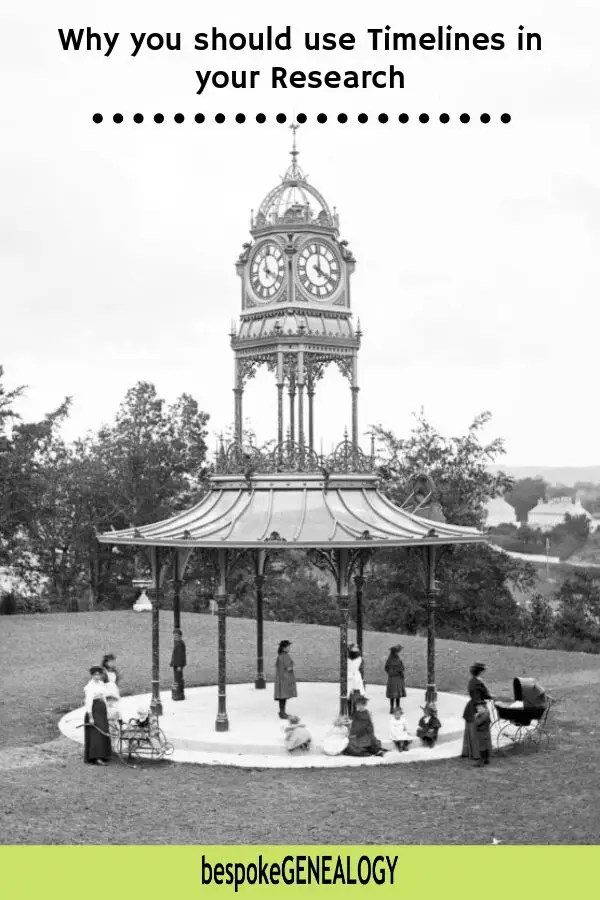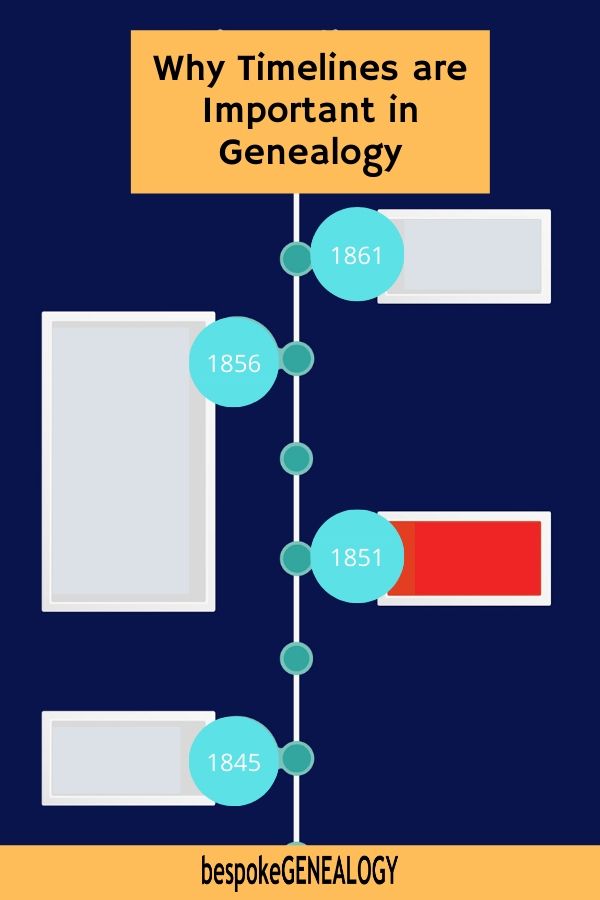 Family History Success. Bespoke Genealogy" width="" height="" />
Family History Success. Bespoke Genealogy" width="" height="" />One of the most important tools in a family historian’s box is the timeline. When used properly they can give a visual overview of someones life and can even help break down brick walls. Yet timelines are often overlooked or not used as a research aid. This post looks at timelines, how to create them, what should be on them and how they can help with your research.
 Family History Success. Bespoke Genealogy" width="" height="" />
Family History Success. Bespoke Genealogy" width="" height="" />
A timeline is basically a list of events in chronological order. For a person, a timeline would start at his/her birth and finish with his/her death. In between would be all the events that had an impact on the life of that person.
Genealogy researchers use timelines in various different formats. They can simply be written down on blank sheets of paper or on pre-printed forms. You can download a pre-printed timeline form at Family Search here . You can also find timeline forms using different layouts on other websites.

Family Search Timeline Form
You may find it easier to use a spreadsheet to create a timeline. Here you can easily insert new key dates and facts as you come across them. I used a spreadsheet for a residence timeline for several years before I got family tree software on my computer. I used this to track where my relatives were living every year. Doing this often led to other genealogy clues. Here is part of that spreadsheet:

Residence Timeline Spreadsheet
The family tree software that I use ( Family Tree Maker ) has a timeline function which I use constantly. Here is part of the timeline on FTM for my relative Edward McGowan:

Family Tree Maker Timeline; Edward McGowan
The great thing about FTM is that you can add events from family members into the timeline and also World events (more about this below).
Some online trees, like Ancestry and Family Search also have timeline functions. On Ancestry, in a person’s profile, select “LifeStory”. This will give you the timeline for that person. Using the “Show” button, like FTM, you can also select “Family Events” and “Historical Insights”. Here is an example of part of a timeline from my tree:

Timeline on Ancestry
Of course, the more facts on the timeline, the more useful they are.
In an earlier article; Don’t make this Common Genealogy Mistake , I talked about why focusing solely on your direct lines is often a mistake. I discussed the importance of looking at other relatives, especially siblings, and by doing so; build up a much fuller picture of a person’s life.
I used my great grandfather Robert McGowan as an example. I showed that, although I didn’t have much direct information relating to him, by extracting facts from all of his children, I could fill in a lot of missing gaps.
By using the “Timeline” option on FTM, I can get an even more detailed look at Robert’s life. Here is part of his timeline from FTM:

FTM Robert McGowan Timeline.
So, how can this help? Well, in two main ways really. Firstly you can see pretty quickly if something doesn’t look right or should be investigated. On Robert’s timeline he was born in Ireland, was living in Glasgow, Scotland in his 20s, and then moved back to Ireland in his 30s, before returning to Scotland again in his 40s to live out the rest of his life. I thought it was strange that he would return to Ireland for a few years, so I investigated further until I was happy that everything was correct.
If something doesn’t look right, it will stick out like a sore thumb!
The other benefit of a timeline is that it can lead to other useful facts. For example, knowing where Robert McGowan was living in Glasgow has led me to other McGowans in the same area that could be his siblings. I’m investigating these at the moment, and hopefully, I can eventually go back further in time. Addresses and occupations can lead you to determining who a person was working for. If you’re lucky, you may find employment records.
By adding world events to a timeline, you can see an even bigger picture. Here’s Robert’s timeline with them added:

Robert McGowan Timeline on FTM with World Events
I can see the 1845 Irish famine. So, this could be the reason that Robert came to Scotland in the first place, and did he come with his family? It also shows the Crimean War in 1853. Did Robert join the army? This needs to be investigated.
If you are not using timelines, I hope you can see how useful they are.
Please pin a pin to Pinterest:
 Family History Success. Bespoke Genealogy" width="" height="" />
Family History Success. Bespoke Genealogy" width="" height="" />












 Family History Success. Bespoke Genealogy" width="600" height="900" />
Family History Success. Bespoke Genealogy" width="600" height="900" />
Originally from London with roots spread across the British Isles; Alistair now lives in Markham, Ontario. A former purchasing manager, he is now a full time genealogist and blogger and holds a Postgraduate Certificate in Genealogical, Palaeographic and Heraldic Studies from the University of Strathclyde in Scotland as well as an MBA from the Open University in England.